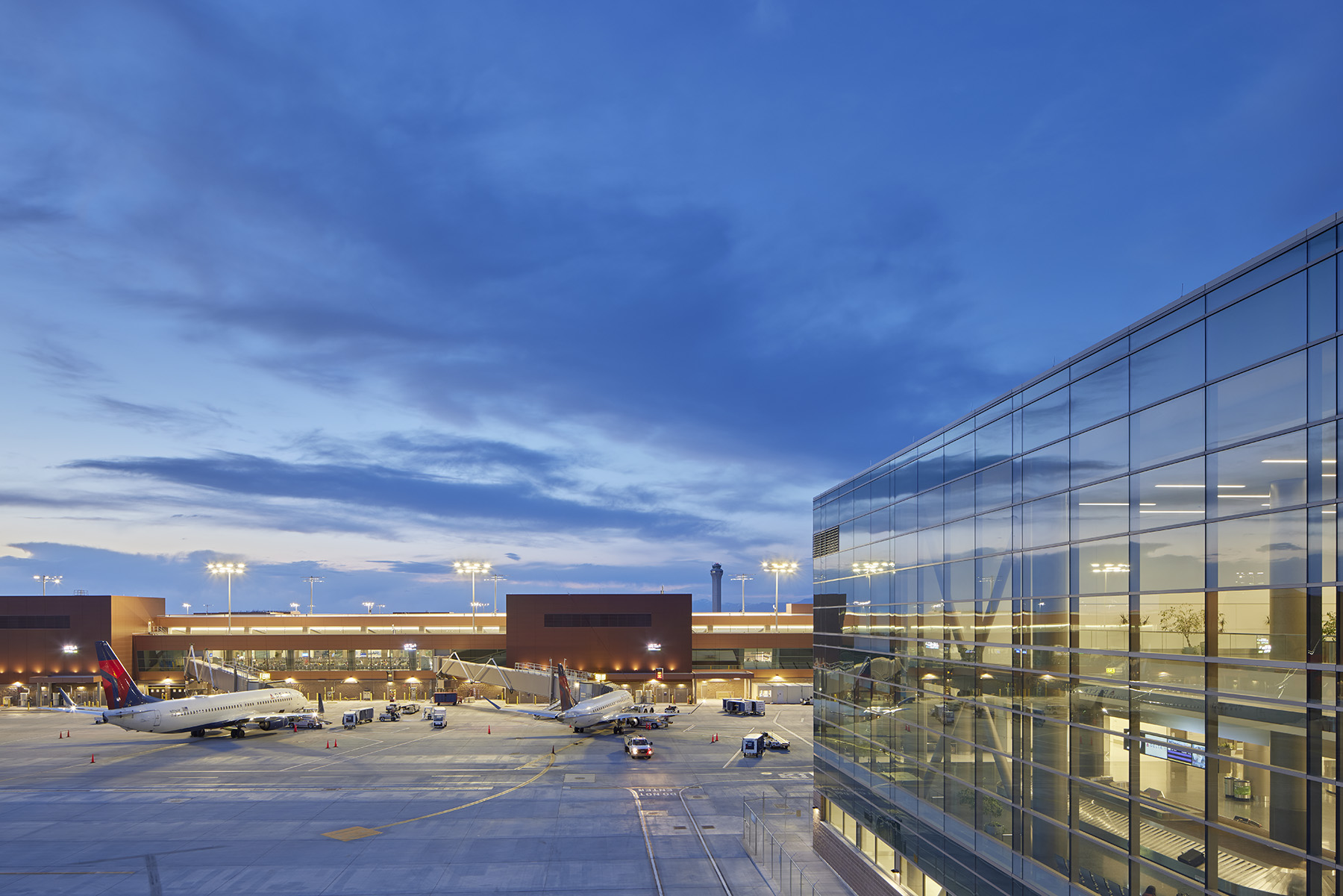
By Robert L. Reid
The new Salt Lake City International Airport terminal and concourses represent the first new hub airport constructed in the United States during the 21st century. Designed to accommodate the site’s seismic and geotechnical challenges, the $4.1 billion project is striving to modernize, improve, and expand the facility’s operations and amenities for airlines and passengers alike while also creating a strong aesthetic focused on the region’s surrounding landscape.
To fly into Salt Lake City International Airport can involve passing over some of Utah’s most distinctive and significant geological features.
Coming in from the east will almost certainly bring you over the Wasatch Fault, an active seismic zone that produced a magnitude 5.7 earthquake in March 2020, briefly closing the airport and causing minor damage to the existing facilities; the fault could someday produce an earthquake of magnitude 7.5, according to information from the U.S. Geological Survey.
If you approach the airport from the south, you might fly over one of the state’s slot canyons, which are long, narrow gorges formed in the soft rock of layered sedimentary deposits. Utah has some of the largest concentrations of slot canyons in the world.
And coming in from almost any direction will bring you over what historically have been the region’s copper deposits — especially Bingham Canyon, to the southwest, long the site of one of the world’s largest copper mines.
All three — the seismic hazards, the slot canyons, and the extraction of red metal — played roles in the recent design and construction of a new terminal and two new concourses at Salt Lake City International Airport. The $4.1 billion airport redevelopment project includes a new 909,000 sq ft terminal and two new concourses, both linear structures located north of the terminal. The concourse nearest to the terminal is designated the south concourse and will ultimately measure roughly 3,800 ft long; the structure farther from the terminal is designated the north concourse and will eventually measure 3,400 ft long.
Other new features include a 3,600-vehicle parking garage that has twice the capacity of the airport’s original parking structure and a 7 mi long baggage conveyor system. Two new tunnels, each nearly 1,000 ft long, will link the terminal and concourses to move baggage and people, the latter via a new underground train system. More than 2,000 ft of elevated roadway and various amenities intended to upgrade, expand, and modernize the facility for airlines and passengers alike are also part of the project.
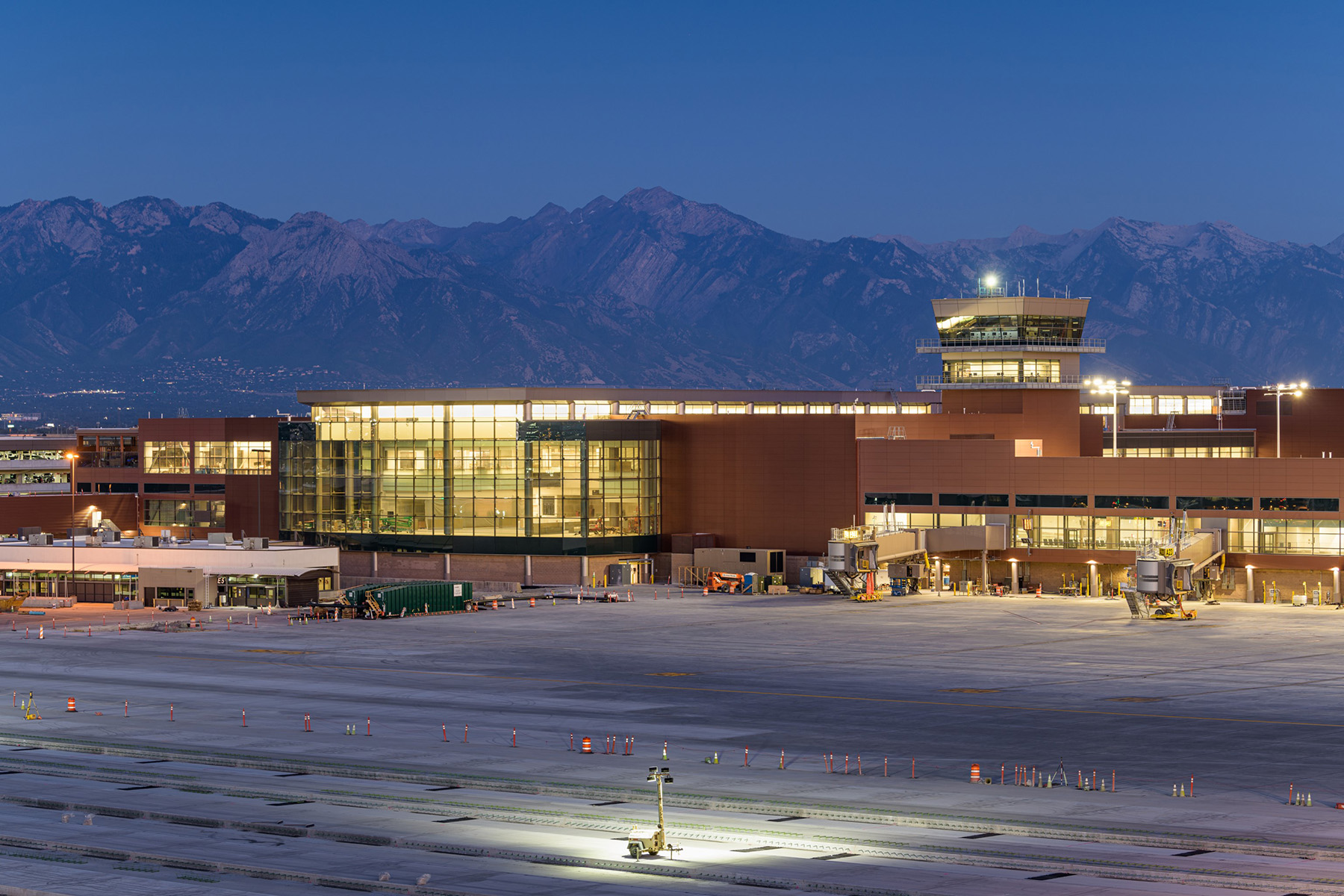
The international architecture, planning, and engineering firm HOK is responsible for the project’s architectural, structural, and interior design as well as the mechanical and electrical systems, landscape architecture, planning, lighting, experiential and graphic design, and sustainable design. HNTB, based in Kansas City, Missouri, is the project’s civil engineer. HDJV, a joint venture of Atlanta-based Holder Construction Group LLC and Big-D Construction, based in Salt Lake City, is the general contractor for the new terminal, the south concourse, the new parking garage, the elevated roadway, and other aspects of the project. The north concourse is being constructed by AOJV, a joint venture of Dallas-based Austin Commercial and Salt Lake City-based Okland Construction.
Salt Lake City International Airport is a major hub for Delta Air Lines, which was involved in key aspects of the project’s planning, says Matt Needham, AIA, LEED GA, NCARB, director of aviation and transportation, based in HOK’s San Francisco office.
In addition, Gordon Huether, an artist based in Napa, California, created a series of large-scale installations for the airport that were inspired by the Salt Lake City community and surrounding landscape.
Phasing and funding
The new facilities at Salt Lake City International Airport represent the first hub airport constructed in the United States during the 21st century. They replace the site’s original facilities, which were constructed in the 1950s and 1960s and included two terminal buildings plus an international arrivals building. Together, the original buildings provided 71 gates for domestic flights and three international gates — only 55 of which featured jet bridges. These gates were arrayed along a series of concourse piers that extended from the other buildings like fingers on a hand, explains Needham.
By contrast, the single new terminal building takes the place of three older structures, and the two new concourses will feature a total of 78 domestic gates and six international gates, all with jet bridges. When the project is completed, the airport should be able to accommodate 34 million passengers annually; the airport served 26.8 million passengers in 2019.
Because portions of the new facilities are being constructed directly on top of the site of the original facilities, the project has been divided into two phases to accommodate the eventual demolition of the old terminals and concourses.
During the first phase, the new terminal building and the western portion of the south concourse — a portion of the concourse encompassing more than 456,600 sq ft — were constructed adjacent to the original terminal buildings and the fingerlike concourses. This work was completed in September 2020. The western portion of the north concourse opened a little more than a month later with more than 476,600 sq ft of space. The new parking garage and various adjoining facilities also opened during 2020, and the demolition of the older parking garage began.
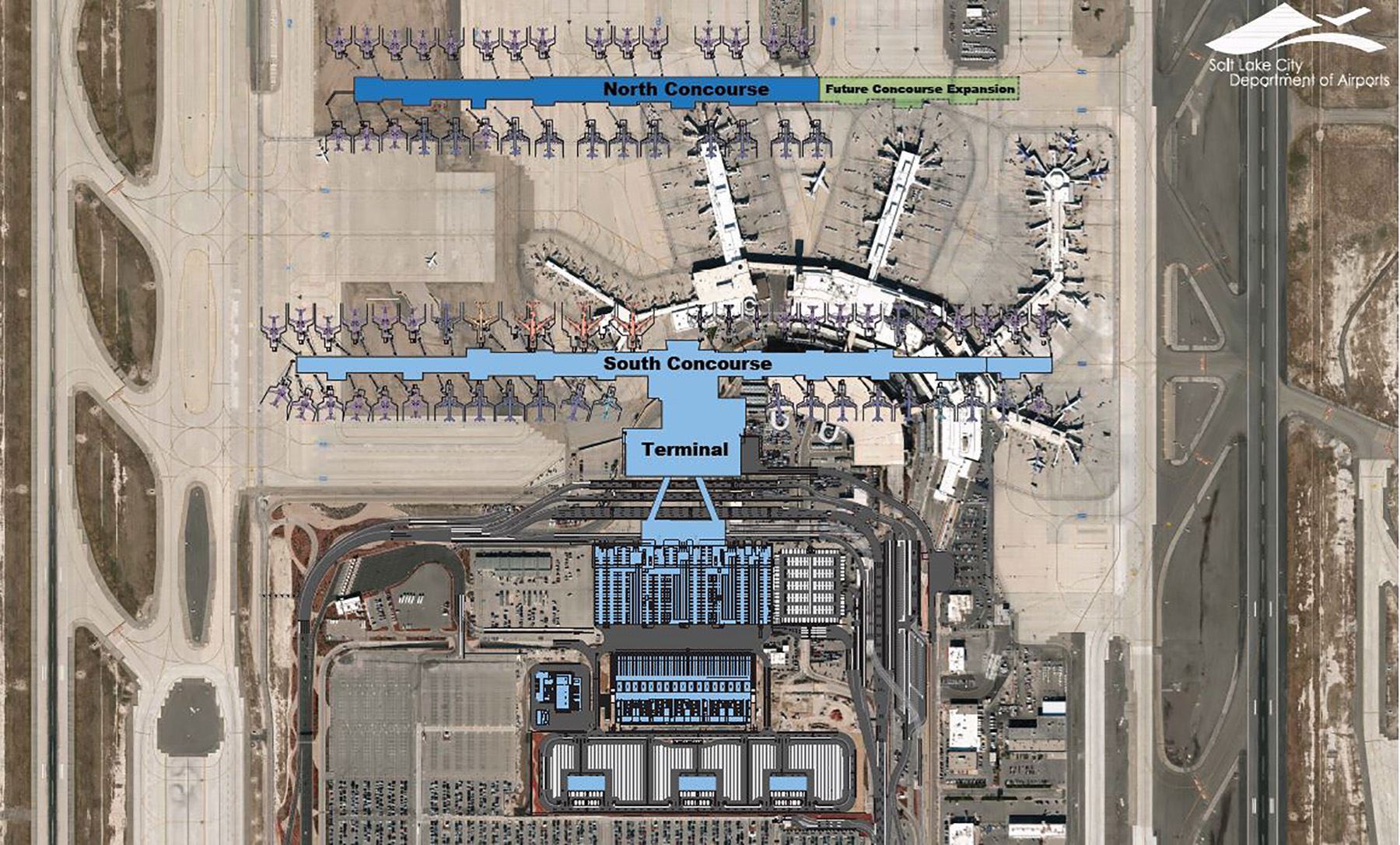
The original terminals and concourses will be demolished over the next several years, and the project’s second phase will then add another 370,700 sq ft to the eastern side of the south concourse and another 364,000 sq ft to the eastern side of the north concourse, both on the sites of the earlier facilities. The second phase, which includes the underground people mover system and tunnel, should be completed by roughly October 2025.
The airport’s new concourses have been designed to accommodate additional expansion in the future without seriously disrupting overall airport operations, notes Needham.
The project is being funded by user fees — primarily by the airlines — as well as car rental fees, passenger facility charges, airport revenue bonds, and money the airport has been setting aside for the project over the years, explains the airport website. No local tax dollars are being spent.
Replacing versus retrofitting
HOK became involved in the new airport project as the master architect in 2008, at a time when the Salt Lake City Department of Airports, which operates the international airport, was considering whether to upgrade and retrofit the existing facilities, says Claire Moore, P.E., S.E., LEED AP BD+C, and engineering practice leader in HOK’s San Francisco office. But various factors convinced the airport’s leadership that the construction of new facilities was preferable. The reasons included the fact that extending the existing concourse piers out farther to add more gates would likely increase delays and the consumption of jet fuel as multiple aircraft tried to pull up to or depart from the increasingly constricted spaces between the piers at the same time.
The original buildings also did not meet current seismic codes or the mechanical system performance levels expected today, Moore adds.
To replace the original buildings with new buildings overlapping the footprint of the original terminals and piers required that the work be conducted in a complicated series of stages within the project’s two main phases. During these various stages the number of gates available would increase and decrease over time and vary by location as different parts of the original facilities were taken out of operation and construction was completed on each part, Moore explains.
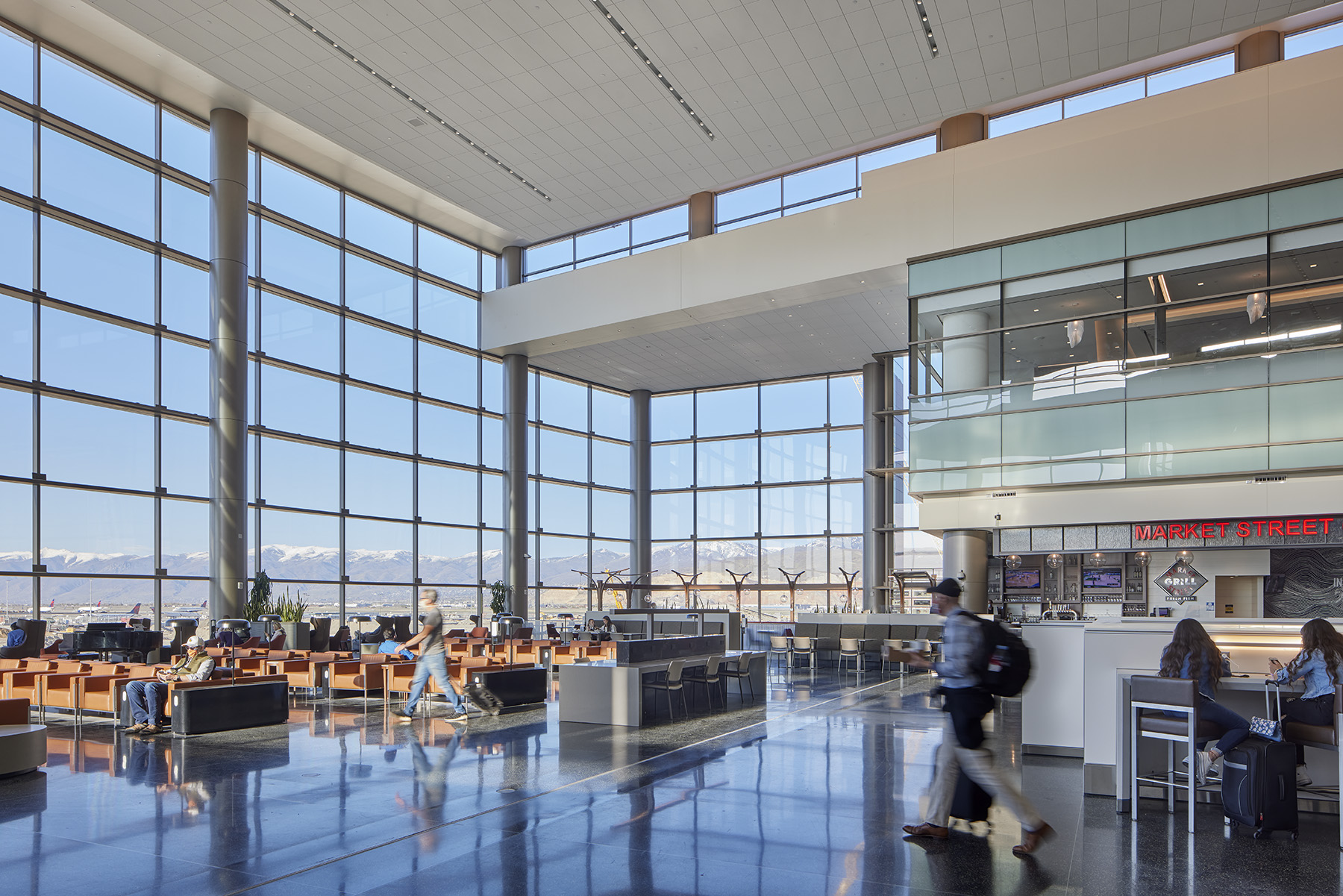
At certain points during the construction work, the airport will load and unload passengers at hardstand sites just northeast of the new north concourse. Hardstand sites refer to the times when an aircraft is parked on the ramp and passengers are transported to or from the airplane via a shuttle bus rather than using a jet bridge directly at a gate.
As the largest public works project in Utah’s history, the airport redevelopment faced numerous challenges, including the COVID-19 pandemic, which led to measures such as mask requirements and, once the first phase of work was completed, the use of plexiglass shields in areas where passengers might gather. At the same time, the global slowdown in air travel caused by the pandemic also helped accelerate some demolition work and reduce the overall construction schedule for the second phase, notes Needham.
Separating structures
The new terminal building is a three-level, predominantly steel-framed structure with deep foundations. The geotechnical conditions at the airport feature interbedded sediment layers, some of which can support the terminal loads and some of which cannot, Moore says. So the foundation system features steel pipe piles, 16 in. in diameter and filled with concrete, that measure roughly 74 ft in length to ensure they extend down far enough to anchor the facility in adequate bearing strata, she explains.
The terminal building is essentially split into three separate structures to accommodate seismic joints as well as thermal movement because of the potentially large temperature swings caused by the site’s high desert conditions, says Moore. Most of the terminal framing features buckling restrained braces, she adds. But a portion also pairs that bracing with a side-plate special moment-resisting frame to accommodate uninterrupted passenger movement at the building’s second level.
The system also provides the open space necessary for the at-grade baggage handling equipment as well as for the planned tunnel in the basement that will feature an extensive system of baggage-transfer belts and a connection to the automated people mover train system.
Like the terminal, the north and south concourses feature similar three-level, steel-framed designs with deep foundations.
A total of roughly 3,200 piles were installed throughout the project site. In addition, a series of stone columns were installed beneath the at-grade concrete slabs at the base of the terminal and the concourses to strengthen the underlying soil. That soil is soft, has a high groundwater table, and is subject to potential liquefaction under seismic loads, says Moore.
Malcolm Drilling, based in San Francisco, used vibrocompaction techniques to install some 7,600 stone columns to depths of 30 ft to 45 ft to stabilize the ground beneath the new facilities. The firm also relied on temporary excavation shoring using a triple-auger soil-mixing technique and a deep dewatering system, including recharge wells. Malcolm will use similar techniques, along with an estimated 95,000 sq ft of soldier piles and lagging, for the planned tunnel linking the terminal to the concourses.
Arriving and departing
To the north of the terminal, taxiways located between the north and south concourses will enable large aircraft to simultaneously taxi past one another, improving the efficiency of aircraft movement and reducing airfield congestion, notes Needham.
To the south of the terminal are several new structures designed to improve the experience of passengers and other visitors who arrive at the airport by rental cars or their own vehicles. These include the new concrete-framed parking garage, which features a camera system to identify where open spaces can be found, and twin pedestrian bridges that provide access from the garage to the terminal.
Between the garage and the terminal is also a structure called the Gateway Center that provides access for arriving passengers to rental car counters and other ground transportation options, all on the same level as the terminal’s baggage claim area. Previously, such connections had been at least one level apart, explains the airport’s website.
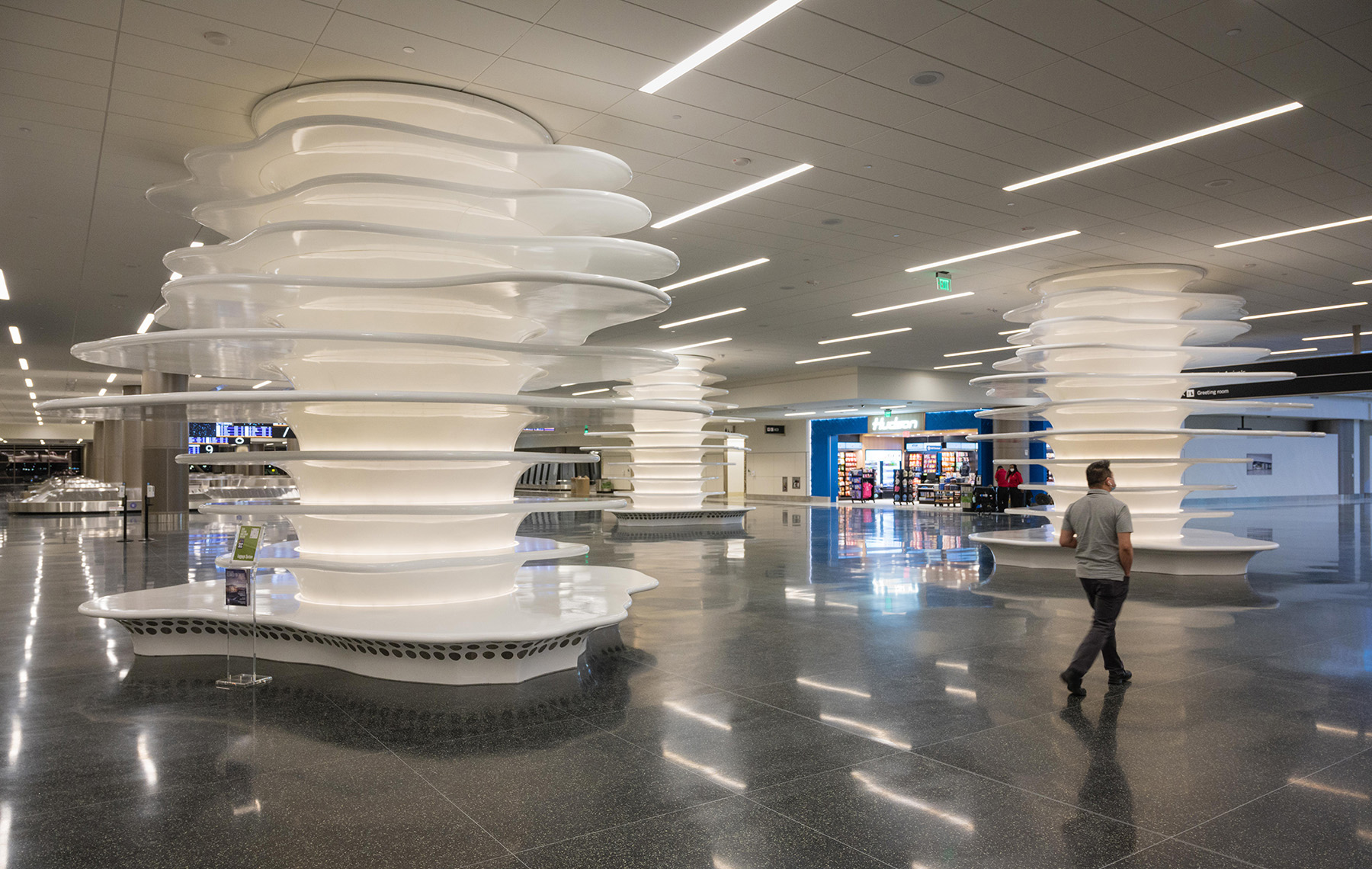
Likewise, for departing passengers, the Gateway Center provides the facilities to drop off checked luggage right outside the parking garage. Passengers can then cross a pedestrian bridge to access the terminal at the same level as the Transportation Security Administration checkpoint. “You go right through security and you’re on your way to your gate, all on one contiguous level so the pedestrians are separated from roadway traffic” approaching the terminal, Moore explains.
Directly south of the parking garage is a structure known as the Quick Turn Around Facility as well as a series of service center buildings, all of which are aimed at getting rental cars returned and processed or serviced quickly and conveniently so the vehicles can be moved to the ground floor of the parking garage to be rented again, explains Moore. These facilities have been centralized near the parking garage rather than spread out across the airport grounds, as previously was the case, she adds.
Securing and sustaining
The centralized security checkpoint within the terminal features automated screening lanes that enable multiple travelers to use the system simultaneously, placing their bags and other items in bins that are larger than traditional airport screening bins, explains the airport’s website. The automated system features 45 in. wide conveyor belts — compared with traditional widths of 36 to 39 in., notes Needham — and large-radius turns that can accommodate big items, including skis and bicycle boxes, that previously had to be screened by hand.
The terminal’s moment-frame structural system and a reinforced floor system in the security area create large, open spaces to accommodate possible expansion of the security screening activities as well as the potential for larger, heavier screening equipment in the future, Moore notes.
The baggage handling system’s miles of conveyor belts operate with stop-start magnetic motors that run only when there are bags on the belt. “When there are no bags to move, there are sensors that will shut down segments of the belts to save energy,” says Needham. The system is part of the project’s environmental program that earned the new airport facilities a gold-level certification in the U.S. Green Building Council’s Leadership in Energy and Environmental Design rating system, Needham adds.
Other features of the project’s environmental and sustainability efforts include the use of high-bay windows as tall as 50 ft in places on the north side of the terminal and concourses to maximize the amount of daylight; a light-harvesting system measures that daylight and dims or turns off lights to reduce the power loads when the natural light is sufficient, says Needham. Conversely, a stepped roof system with clerestory lights and low-angled glass windows is used on the southern side of these structures to accommodate the harsher, southern light, he says.
Displaced air ventilation systems are also incorporated within the steel-framed structural columns located in the major public spaces of the terminal and concourses, notes Needham. Instead of blowing conditioned air across wide areas, these systems focus slow-moving cold or heated air near the floors of the occupied areas of the buildings while forcing waste air to the ceiling to be expelled through exhaust panels — an approach that reduces energy consumption. Radiant heating and cooling systems are embedded in some of the floor slabs, Needham adds.
The airport also hopes to convert all its ground support vehicles to electric vehicles by 2024.
Designing for place
The project team was tasked with developing a design for the new facilities that was highly functional, affordable, and “tasteful in a timeless manner,” says Needham. But at the same time, the airport’s operators did not want a “generic, faceless place.” Instead, the goal was to incorporate the aesthetics of the Salt Lake City region and Utah overall into the design.
“We tried to represent a local Utah materiality,” says Needham. “There’s a long history of copper mining in the state, so a lot of the exteriors feature metallic copper panels” that are repeated on interior spaces.
Most significantly, HOK worked closely with Huether on a series of large-scale installations inspired by the landscapes and imagery of the city and state.
The largest of these is called The Canyon and was inspired by Utah’s slot canyons, especially “the way light affected the weathered rock formations,” explains a description of the project on Huether’s website. Located within the terminal, along the east and west walls of an atrium, The Canyon measures more than 362 ft in length and features an undulating structure near the ceiling, supported on an aluminum frame and illuminated by a customized, variable light program designed to “recreate the warmer orange and red colors reflected in Utah’s red rock canyons during the daytime, and the cooler blue and purple hues at night,” according to the website.
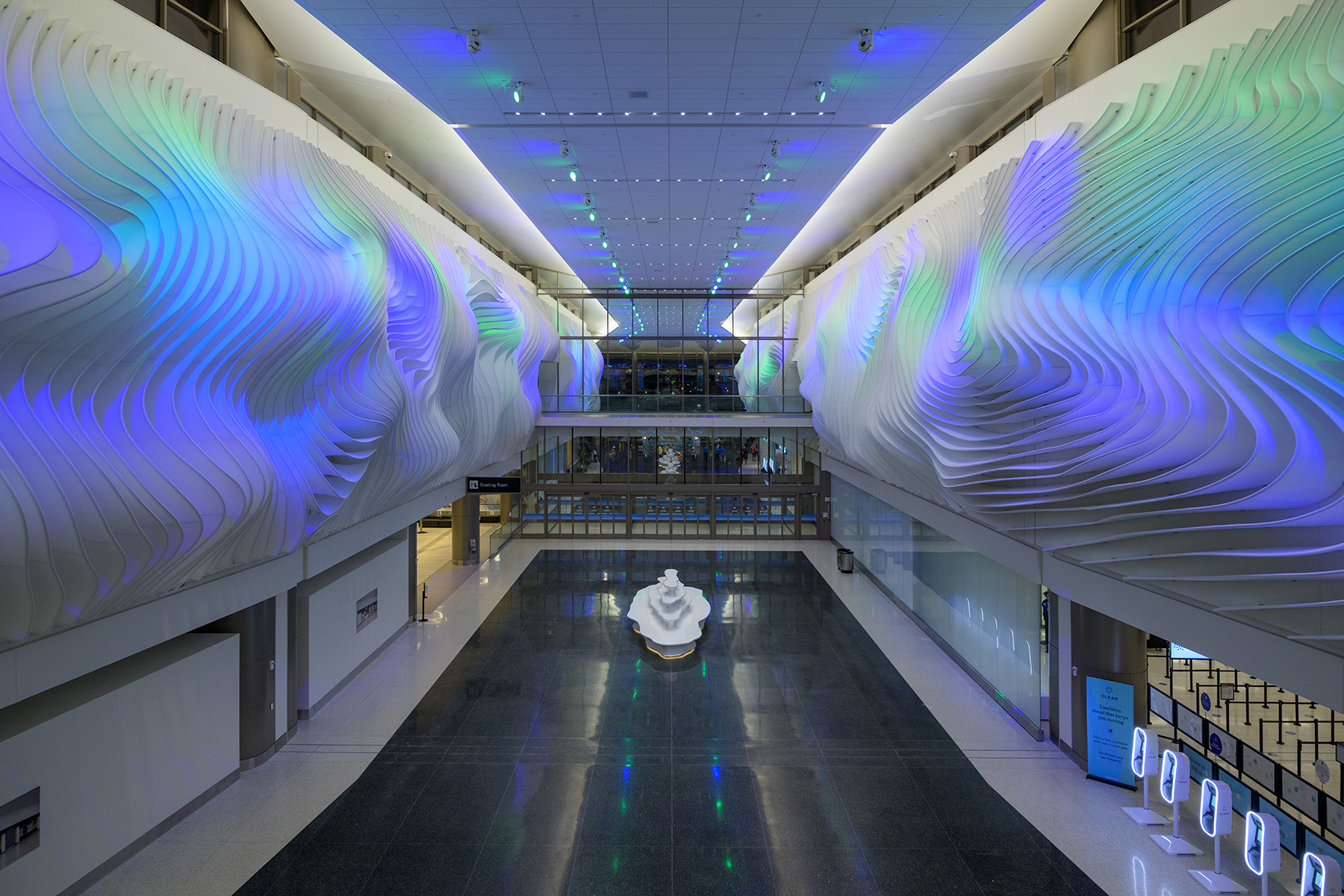
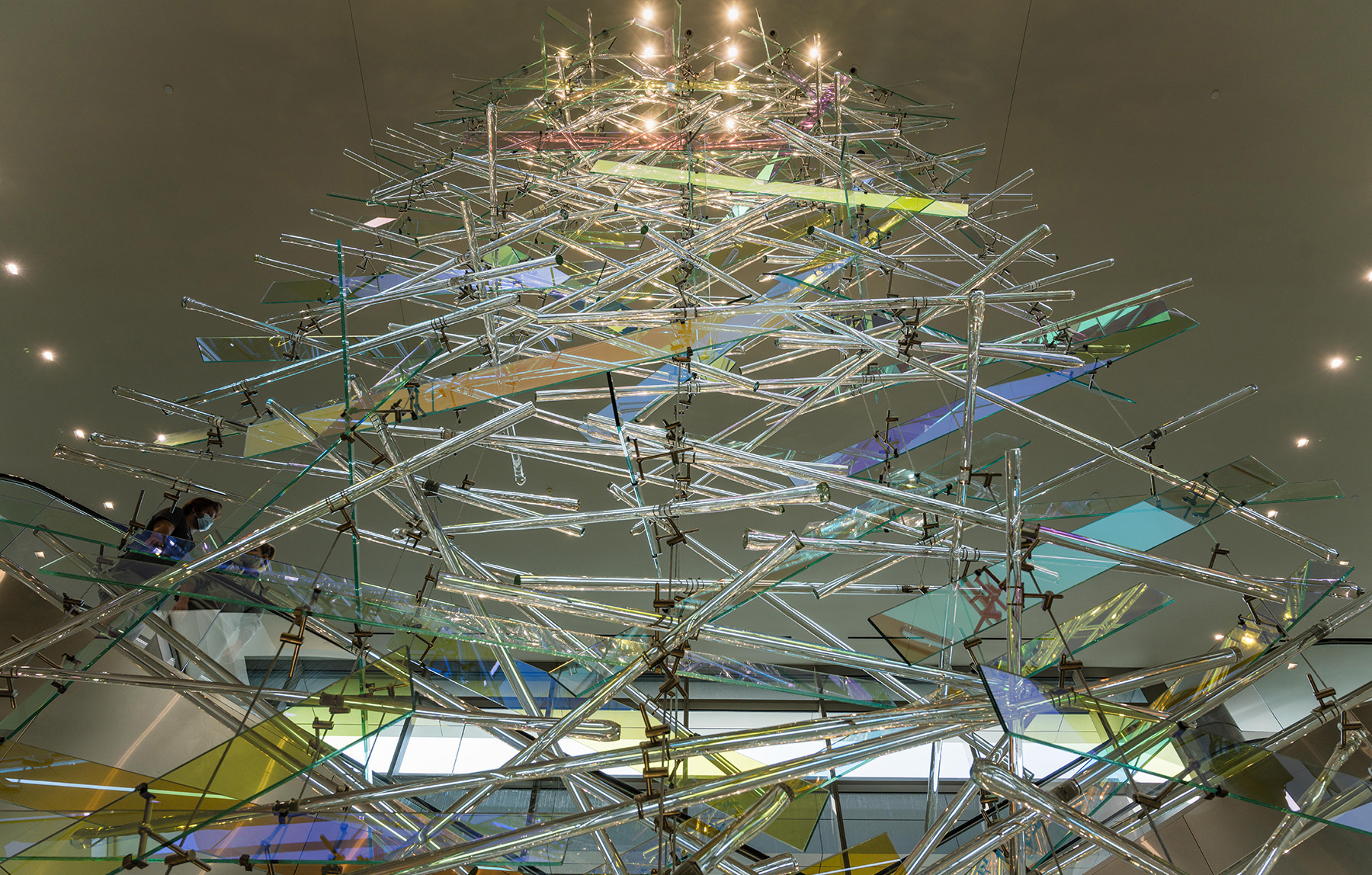
Another significant piece of art is called The Falls. Suspended within an escalator well near the terminal entrance, the installation is 65 ft tall and weighs 5,000 lb. It features some 300 dichroic glass panels and 220 glass rods supported by stainless steel cables. The light-sensitive panels and light-refracting rods were inspired by the waterfalls found throughout Utah’s canyon landscapes.
Located in a gathering area within the terminal is Column Plates, a series of structural columns, 18 ft tall, that are wrapped in composite plates that extend from the columns, some of them forming seats at their base. Seating is also provided by massive benches that measure 28 ft long, 10 ft wide, and 5 ft high. Both pieces were designed along the same structural themes as The Canyon.
Additional artwork is planned for the north concourse, including another sculpture similar to The Canyon, dubbed Canyon 2.0, and a half-spherical structure that will feature a stainless steel framework and glass elements similar to those used in The Falls. Weighing more than 3 tons, the installation known as Northern Light required reinforcement of the concourse wall that will support it.
The planned tunnel connecting the terminal to the north concourse will also feature a membrane sculpture suspended from the tunnel ceiling. Known as River Tunnel, the installation will also use an aluminum frame and fabric fins, similar to The Canyon, with lighting and sound displays designed to create the impression of a river.
“Our close collaboration with HOK at Salt Lake City Airport is based on our joint approach to integrating art in transportation and transit systems,” Huether explains. “When done successfully, it’s an opportunity to engage travelers and revitalize their experience of the transit space.”
Making connections
The sense of place that was so critical to the design of the new Salt Lake City International Airport manifested itself in ways physical and emotional. On the structural side, the fact that the site of these new facilities lies in an active seismic zone was brought home with dramatic clarity by the 2020 earthquake. Although construction on the project halted briefly so that teams could examine the facilities, only minor damage was discovered, allowing work to resume quickly.
“The shaking and magnitude were a good test of the systems,” Moore says.
On the emotional side, an airport represents the place from which many travelers leave or to which they return home. In Salt Lake City, this is especially true for the area’s large population of members of the Church of Jesus Christ of Latter-day Saints. LDS missionaries leave home to travel the world, and the new airport facilities can be the last place where they see their loved ones before they depart and the first place where they greet them upon their return.
In the original Salt Lake City International Airport, these global journeys were highlighted through an enormous map of the world, set in tile in the floor of one of the terminal buildings. Families sometimes came to picnic on the map, sitting on blankets over the site of where their relative had been or was headed, explains the airport’s website. And while the tile map itself could not be moved or preserved, its image was photographed and reproduced by Huether in a 10 ft high glass panel that now hangs in a large meeting room located outside the secure area of the new terminal.
This room, which also features a fireplace and tall windows with mountain views, is a space both public and, in other ways, intensely private. It helps connect families that are beginning or ending long separations. It connects the new airport to the old. And, metaphorically, at least, it connects Salt Lake City to the world, just as the planes that use the airport’s runways, terminals, and concourses do physically.
Robert L. Reid is the senior editor and features manager of Civil Engineering.
PROJECT CREDITS
Client: Salt Lake City Department of Airports
Architecture, structural engineering, mechanical and electrical systems, interior design, landscape architecture, planning, lighting, experiential and graphic design, and sustainable design: HOK, San Francisco office
Local architecture partners: ArchNexus, MHTN Architects, GSBS Architects, and FFKR Architects, Salt Lake City
Local structural engineering partners: Dunn & Associates and Reaveley Engineers + Associates, Salt Lake City
Local mechanical and electrical systems partner: Colvin Engineering Associates, Salt Lake City
Civil engineering: HNTB, Kansas City, Missouri
Baggage handling system consultant: CAGE Inc., a Ross & Baruzzini company, St. Louis
General contractor for the terminal, south concourse, parking garage, and elevated roadway: HDJV, a joint venture of Holder Construction Group LLC, Atlanta, and Big-D Construction, Salt Lake City
General contractor for north concourse: AOJV, a joint venture of Austin Commercial, Dallas, and Okland Construction, Salt Lake City
Artistic consultant: Gordon Huether, Napa, California
This article first appeared in the May/June 2022 issue of Civil Engineering as “A Sense of Place.”



